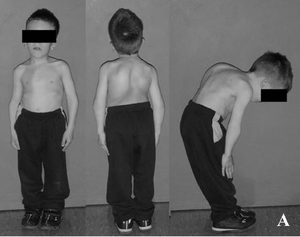Spondyloepiphyseal dysplasia
| Spondyloepiphyseal dysplasia congenita | |
|---|---|
 |
|
| A 6 1⁄2-year-old male with spondyloepiphyseal dysplasia congenita. Short stature, disproportionately short trunk, and kyphoscoliosis. | |
| Classification and external resources | |
| Specialty | medical genetics |
| ICD-10 | Q77.7 |
| ICD-9-CM | 756.9 |
| OMIM | 183900 |
| DiseasesDB | 29410 |
| eMedicine | orthoped/630 |
Spondyloepiphyseal dysplasia congenita (abbreviated to SED more often than SDC) is a rare disorder of bone growth that results in dwarfism, characteristic skeletal abnormalities, and occasionally problems with vision and hearing. The name of the condition indicates that it affects the bones of the spine (spondylo-) and the ends of bones (epiphyses), and that it is present from birth (congenital). The signs and symptoms of spondyloepiphyseal dysplasia congenita are similar to, but milder than, the related skeletal disorders achondrogenesis type 2 and hypochondrogenesis. Spondyloepiphyseal dysplasia congenita is a subtype of collagenopathy, types II and XI.
People with spondyloepiphyseal dysplasia are short-statured from birth, with a very short trunk and neck and shortened limbs. Their hands and feet, however, are usually average-sized. This type of dwarfism is characterized by a normal spinal column length relative to the femur bone. Adult height ranges from 0.9 meters (35 inches) to just over 1.4 meters (55 inches). Curvature of the spine (kyphoscoliosis and lordosis) progresses during childhood and can cause problems with breathing. Changes in the spinal bones (vertebrae) in the neck may also increase the risk of spinal cord damage. Other skeletal signs include flattened vertebrae (platyspondyly), a hip joint deformity in which the upper leg bones turn inward (coxa vara), and an inward- and downward-turning foot (called clubfoot). Decreased joint mobility and arthritis often develop early in life. Medical texts often state a mild and variable change to facial features, including cheekbones close to the nose appearing flattened, although this appears to be unfounded. Some infants are born with an opening in the roof of the mouth, which is called a cleft palate. Severe nearsightedness (high myopia) is sometimes present, as are other eye problems that can affect vision such as detached retinas. About one-quarter of people with this condition have mild to moderate hearing loss.
...
Wikipedia
